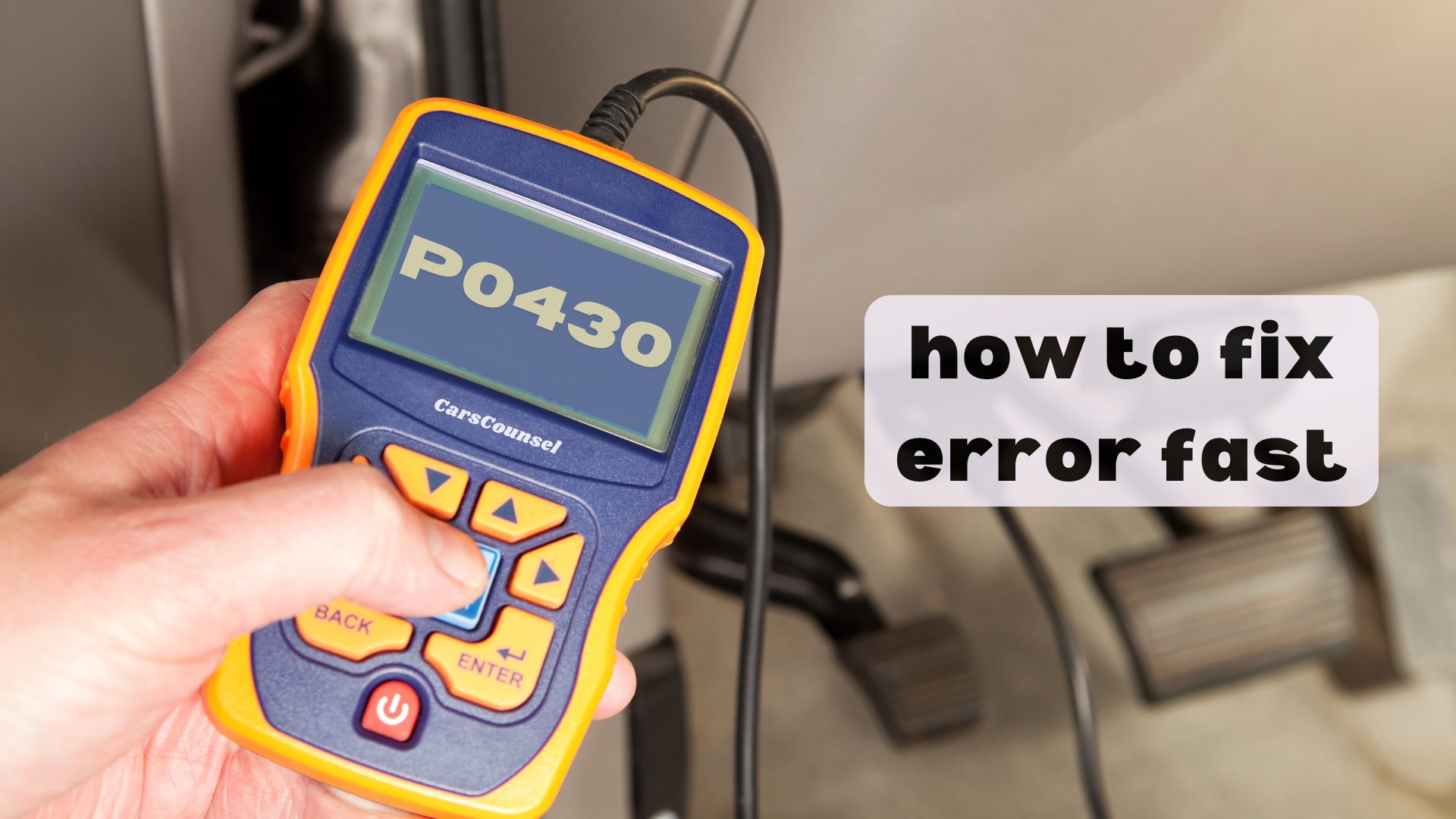Dealing with a P0430 code can be annoying, especially when it messes with your car’s performance and emissions.
First, use an OBD-II scanner to confirm the error. This will help you figure out if the problem is with the oxygen sensors, the fuel system, or an exhaust leak.
Once you know where the issue might be, check out the exhaust system and the oxygen sensors.
So, what should you do next to fix it quickly and effectively? Let’s go through the steps to diagnose and repair the problem to get your car running smoothly again.

Quick Navigation
Key Takeaways
- Replace Faulty Oxygen Sensors: Check and change any bad oxygen sensors to make sure your emissions readings are accurate.
- Fix Exhaust Leaks: Look over the exhaust system for any leaks and fix them to keep sensor readings correct.
- Address Ignition Issues: Fix misfires by changing spark plugs or coils so unburned fuel doesn’t harm the catalytic converter.
- Check Catalytic Converter: Look at the catalytic converter for any damage or clogs and replace it if needed.
Understanding P0430 Code
The P0430 code means there’s an issue with the catalytic converter’s efficiency on the second side (Bank 2) of your car’s exhaust system. In simple terms, the converter isn’t doing a good job of filtering out harmful emissions, which can get you in trouble with emissions laws.
Here’s how you can tackle this problem step-by-step:
- Use an OBD-II scanner to confirm the P0430 code.
- Check if the catalytic converter has any visible damage.
- Make sure there are no exhaust leaks on the second side (Bank 2).
- Look at how the downstream oxygen sensor is working.
Keeping the catalytic converter in good shape is important not just for passing emissions tests but also for your engine’s performance and fuel efficiency.
Properly diagnosing the issue is crucial to fixing it right.
Common Causes of P0430
Finding the reasons behind the P0430 code usually involves looking at a few key areas: oxygen sensors, ignition misfires, fuel injectors, exhaust leaks, and the catalytic converter.
Start by checking the downstream oxygen sensor since a problem there can cause incorrect readings about the converter’s efficiency.
Next, look for ignition misfires—unburned fuel from misfires can overload the catalytic converter.
Then, inspect the fuel injectors; if they’re faulty, they might send unburned fuel into the exhaust system, which hurts fuel efficiency.
Also, check for exhaust leaks, as these can cause wrong sensor readings.
Lastly, examine the catalytic converter itself. If it’s worn out, it won’t meet emission standards, causing the P0430 code to appear.
Address these areas one by one to ensure your vehicle meets emission standards and runs efficiently.
Symptoms of P0430 Code
Symptoms of a P0430 Code
When your car shows a P0430 code, you might notice several performance issues, including sluggish acceleration and misfires. These problems are often tied to trouble with the catalytic converter and can show up in the following ways:
- Check Engine Light (CEL): The CEL will likely turn on, indicating an emissions issue.
- Poor Fuel Efficiency: You might see a drop in your miles per gallon because of inefficient combustion.
- Increased Emissions: You might smell fuel or sulfur from the exhaust.
Catching these P0430 code symptoms early can help you fix catalytic converter problems before they get worse.
Use an OBD-II scanner to diagnose the issue accurately and then make the necessary repairs.
Impact on Engine Performance
Experiencing a P0430 code can seriously affect how well your engine runs, showing up as slow acceleration and uneven power. This problem hurts engine efficiency and can cause your car to fail emission tests. To fix it, follow these steps:
- Check Engine Light: The check engine light will turn on.
- Performance Issues: You’ll notice a drop in power.
- Fuel Efficiency: Your car will use more gas.
- Emissions: There will be more pollution.
- Catalytic Converter: It might get damaged.
Here’s a quick reference table for symptoms and impacts:
| Symptom | Cause | Impact |
|---|---|---|
| Slow Acceleration | Catalytic converter problems | Reduced engine power |
| Uneven Power | Bad oxygen sensors | Unstable power delivery |
| High Fuel Use | Extra fuel in the exhaust | Worse fuel economy |
| Emission Problems | Inefficient catalytic converter | Fails emission tests |
| Check Engine Light | Detected issue | Needs immediate attention |
Take care of these issues quickly to get your engine running smoothly again.
Diagnosing P0430 Issues
Diagnosing a P0430 code starts with a good look at the catalytic converter to see if it’s in good shape. Using the right tools can make this easier.
First, get an OBD-II scanner to read and understand the codes. This will help you figure out what’s wrong.
Then, check for any leaks or damage in the exhaust system because these can mess with emissions. Also, make sure the oxygen sensors are working properly.
Lastly, ensure there are no ignition misfires or problems with the fuel injectors that could be causing unburned fuel to get into the exhaust.
- Use an OBD-II scanner to read codes
- Look for any leaks or damage in the exhaust
- Make sure the oxygen sensors are working right
These steps are key for figuring out the problem and fixing it efficiently.
Inspecting the Catalytic Converter
When you check the catalytic converter, start by looking for any physical damage like dents or rust that could affect how it works.
Then, carefully inspect the heat shield and nearby parts for rust or cracks.
Make sure all the connections to the exhaust system are tight and not leaking.
Use a flashlight to look inside the converter’s honeycomb structure through the inlet and outlet. If you see any blockages or melting, there’s a problem.
Check the entire exhaust system to find any issues that might impact the catalytic converter, like exhaust leaks or faulty engine parts.
Write down what you find so you can analyze it and make any necessary repairs.
Testing Oxygen Sensors
To check your oxygen sensors, start by plugging in an OBD-II scanner into your car’s diagnostic port to get live data and spot any sensor problems. Follow these steps for effective oxygen sensor testing:
- Check Live Data: Look at the voltage readings of the sensors before and after the catalytic converter. Normal fluctuations mean the sensors are working well.
- Compare Sensor Readings: Look at the data from sensors on both sides of the engine (Bank 1 and Bank 2). Big differences might mean one sensor is bad.
- Do a Voltage Test: Use a multimeter to make sure the oxygen sensor voltage goes between 0.1 and 0.9 volts.
If the sensors don’t pass these tests, you’ll need to replace them to keep your system running smoothly.
Checking for Exhaust Leaks
Start by looking over the entire exhaust system for any signs of damage, rust, or holes that might mean there’s a leak.
First, check the exhaust manifold and gaskets for any visible cracks or wear.
Then, inspect the exhaust pipes to make sure there are no punctures or worn-out sections.
Pay special attention to where the pipes and parts connect; loose fittings can cause leaks.
Use a leak detection spray or soapy water to find smaller leaks—just apply it to suspect areas and look for bubbles.
Listen for hissing sounds while the engine is running, as this can also indicate leaks.
Thorough leak detection is important to ensure an accurate diagnosis and avoid false P0430 code alerts.
Repairing P0430 Code
Start by figuring out what’s causing the P0430 code so you can fix it properly. Do a detailed check and use diagnostic tools to find the root of the problem. Here’s a simple step-by-step guide:
- Replace the catalytic converter: If it’s broken or clogged, swap it out to get the exhaust flowing right again.
- Test the oxygen sensors: Check both the sensors before and after the converter. Replace any that aren’t working properly.
- Fix ignition misfires: Change the spark plugs or ignition coils to stop unburned fuel from messing up the converter.
This straightforward approach helps you fix the problem correctly and efficiently.
Preventive Maintenance Tips
Regular vehicle check-ups help catch issues early, ensuring your car’s exhaust system and catalytic converter stay in top shape.
Schedule routine inspections to find and fix small problems before they get worse.
Use good-quality fuel to cut down on carbon buildup and improve how your engine burns fuel.
Change the air and fuel filters regularly to keep your engine working well.
Pay attention to your engine’s performance for any signs of trouble, like strange noises or lower fuel efficiency.
Follow the manufacturer’s service guidelines, including oil changes and spark plug replacements, to keep your engine running smoothly.
More OBD-II Codes
Frequently Asked Questions
Can Driving With a P0430 Code Damage the Engine Long-Term?
Driving with a P0430 code can harm your engine over time. You might notice your engine not running well, overheating, and using more fuel. Fix the problem quickly to prevent serious damage and expensive repairs.
How Much Does It Cost to Fix a P0430 Code?
Dealing with the costs to fix a P0430 code can be tough. You’ll usually pay between $400 and $2,000 for the repairs, plus about $100 for the diagnostics. The exact price depends on whether you need new sensors or a catalytic converter.
How Long Does It Take to Diagnose and Repair the P0430 Code?
It usually takes about 1-2 hours to diagnose the issue, which involves checking the catalytic converter and oxygen sensors. Fixing the P0430 code can take anywhere from 2 to 4 hours, depending on how complicated the problem is.
Are There Temporary Fixes for a P0430 Code?
Dealing with a P0430 code can be a hassle, but there are some temporary fixes that might help. You can try adding fuel additives, using an OBD-II scanner to clear the code, or checking for and fixing any exhaust leaks. Keep in mind these are just short-term solutions.
Can a P0430 Code Cause a Car to Fail an Emissions Test?
Yes, a P0430 code can cause your car to fail an emissions test. It means your catalytic converter isn’t working properly, which leads to more pollution. Fix it soon to pass inspections and keep your car running well.
Conclusion
Think of your car’s catalytic converter like a coffee filter. If it gets clogged or damaged, your engine won’t run smoothly.
Fixing a P0430 code is like cleaning that filter. Quickly check it with an OBD-II scanner, look for exhaust leaks, and test the oxygen sensors to keep everything running well.
Regular maintenance not only prevents expensive repairs but also keeps your car running smoothly.
Don’t let a small issue turn into a big problem!

